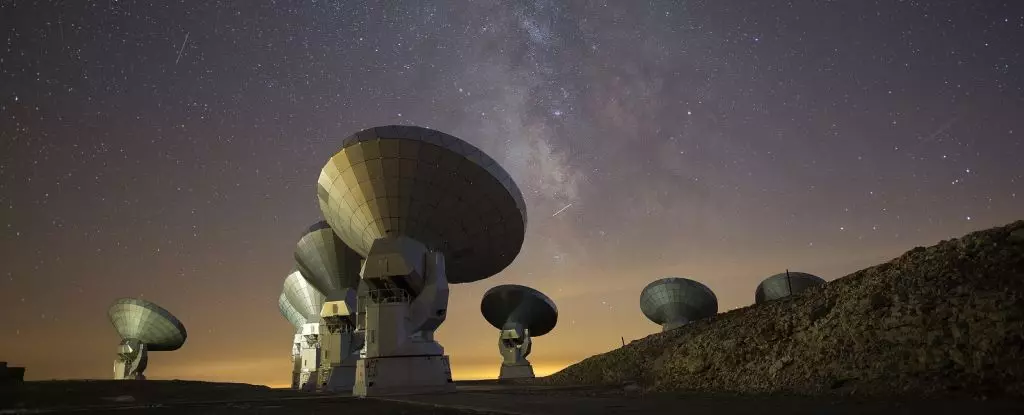In the grand tapestry of the universe, phenomena like gravitational lensing serve as the universe’s storytelling devices—revealing secrets hidden in the depths of space and time. Among these celestial tales, Einstein crosses stand out as extraordinary instances where the warping of light by massive gravitational fields forms symmetrical, cross-shaped images of distant galaxies. These cosmic landmarks are rare—and when phenomena like HerS-3 surprise us with an unexpected fifth image, it compels us to reconsider what we think we understand about the universe’s hidden mass. Such discoveries do more than offer curiosity; they challenge foundational principles, especially concerning the elusive dark matter that composes much of the universe’s unseen mass.
The significance of HerS-3’s peculiar lensing pattern is profound. The classic Einstein cross consists of four distinct light points, a predictable outcome of gravitational warping by a massive intervening galaxy or cluster. Yet, the presence of an additional, centrally located light source disrupts this simplicity. This anomaly hints at complexities beneath the surface—mass distributions more intricate than previously assumed and, most notably, the influence of invisible matter that dark matter represents. HerS-3’s configuration acts as a cosmic clue, an indicator that dark matter halos aren’t just passive gravitational scaffolds but dynamic components capable of dramatically shaping observational phenomena.
This discovery underscores a fundamental truth: our universe is far more mysterious and interconnected than our models suggest. When astronomers initially glimpsed the central blob aligned with the background galaxy’s distance, skepticism was natural. How could an image appear where classical physics dictates it should not? The only plausible explanation, supported by rigorous computer modeling, points to dark matter’s critical role. The invisible halo surrounding the galaxy group acts as a gravitational lens, bending light in unanticipated ways and giving rise to the supplementary image. This isn’t merely an academic curiosity; it validates dark matter’s gravitational influence, providing concrete data to better understand its elusive nature.
Dark matter’s existence, long inferred through inconsistent gravitational effects, now finds another piece of compelling evidence in HerS-3’s lensing pattern. Its suspected presence isn’t based solely on statistical anomalies or indirect observations but on direct modeling of light behavior under extreme gravity. The realization that unseen dark halos can produce such a central image expands our appreciation for how significantly dark matter shapes the cosmos. The cosmic scaffolding hidden in these dark matter halos influences galaxy formation, evolution, and the large-scale structure of the universe itself.
Particularly compelling about HerS-3 is how it acts as a natural, high-powered telescope. The gravitational lensing effect magnifies a distant star-forming galaxy, allowing astronomers to peer into an epoch when galaxies were actively shaping the universe’s early landscape—roughly 11.7 billion years ago. These early galaxies are typically faint and difficult to resolve, making HerS-3’s configuration a rare window into cosmic history. We are granted a glimpse into the universe’s infancy, observing these ancient stellar nurseries as if through a cosmic magnifying glass. This is an invaluable opportunity for astrophysicists seeking to comprehend galaxy evolution and the role dark matter plays in it.
Beyond merely observing distant galaxies, HerS-3 provides critical insights into the distribution and properties of dark matter itself. The modeling indicates that a combination of the intervening galaxy group and a dense dark matter halo is responsible for the complex lensing pattern. This reinforces the notion that dark matter isn’t smoothly distributed but clumps together into massive halos that influence galactic interactions and structural formations. Understanding these halos more precisely could unlock answers to some of the universe’s most persistent mysteries, such as why galaxies take their particular shapes and how dark matter interacts gravitationally with normal matter.
What makes HerS-3 especially significant is its role as a natural astrophysical laboratory. The unique arrangement enables scientists to analyze the small-scale characteristics of dark matter halos and the lensing galaxies with precision. The system helps address longstanding questions about the nature of dark matter—whether it is truly collisionless or if subtle interactions might exist. These small-scale observations could potentially challenge or reinforce our current theories, setting the stage for breakthroughs in fundamental physics. The discovery reiterates that the universe itself, through its natural phenomena, can serve as the ultimate testing ground for our scientific theories.
Finally, HerS-3 exemplifies the power of modern astronomy’s intersection with theoretical physics and computational modeling. Without the advanced simulations ruling out more straightforward explanations, the telltale signs of dark matter’s influence might have remained obscured. The universe is a layered puzzle—one that only reveals its secrets through persistent, detailed exploration and the willingness to question established paradigms. HerS-3’s peculiar lensing pattern not only adds a new chapter to cosmic storytelling but also pushes the boundaries of how we understand the invisible forces sculpting our universe.
In the grand scheme, such discoveries highlight an incredible truth: dark matter, long relegated to the shadows of unknown physics, continues to reveal its secrets in the most unexpected ways. Each anomaly—each Einstein cross with a central image—serves as a reminder that our universe is a complex, dynamic entity, with unseen forces exerting power over the visible cosmos. Unlocking these mysteries will demand relentless curiosity, innovative modeling, and a refusal to accept the universe’s familiar rules as final. The universe’s hidden architecture, powered by dark matter, beckons us deeper into the cosmic mystery—challenging us to look beyond what we see and explore what we cannot.

